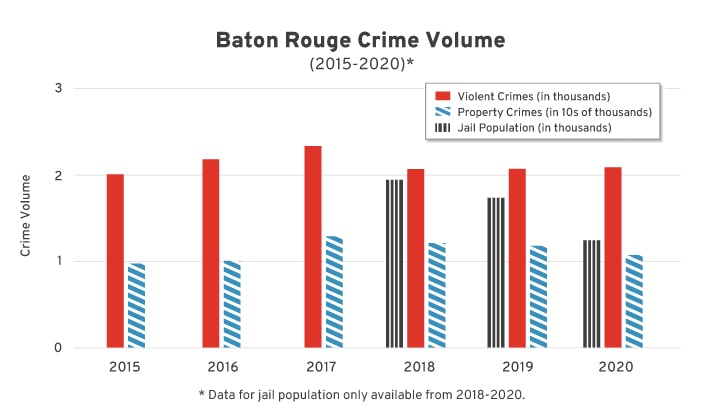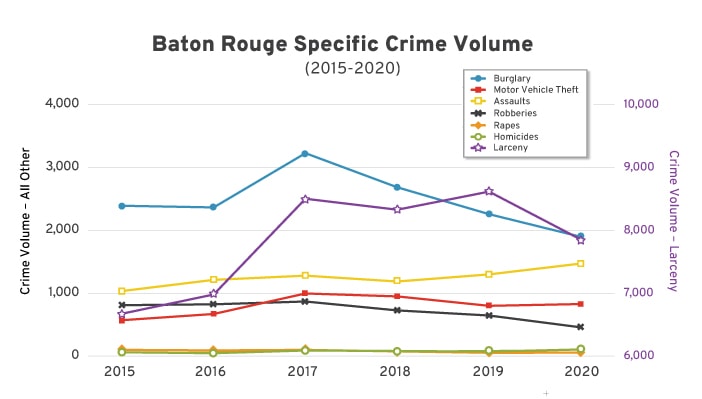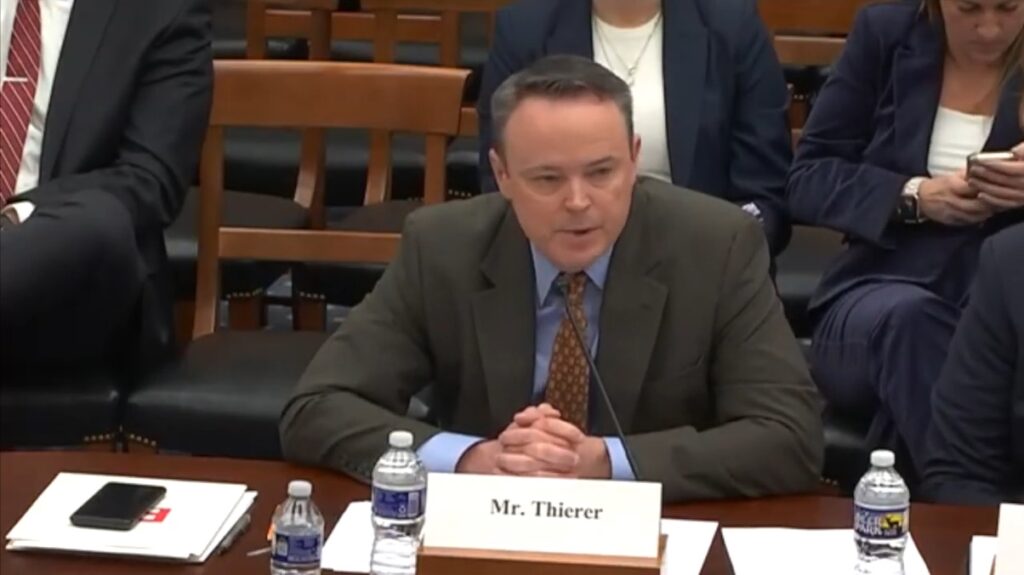Criminal Justice Reform Efforts and Rise in Crime: Spotlight on Baton Rouge, La.
This is the fifth in a series of posts on the subject. Scroll to the end to see the most recent posts in the series.
Introduction
The nation has been captivated by reports of rising crime and the wave of criminal justice reform. Some news outlets and elected officials claim a correlation between the two, but this is perhaps a hasty assessment. In order to better understand how criminal justice reform efforts could be affecting increases in crime, we will be digging into the data, history and current criminal justice reform efforts of six Safety and Justice Challenge sites across the United States. Readers can learn about unique criminal justice reform initiatives in these communities as well as whether the implementation of these efforts (or lack thereof) could be associated with an increase or decrease in crime. To learn more about this series, you can access the introduction here.
Location Information
Baton Rouge, La., is a racially diverse community known for the oil industry, Mississippi river views and the largest state capitol building in the country. Baton Rouge lies within the largest parish in the state and is home to 222,000 of the 450,000 parish residents. East Baton Rouge Parish includes 15 municipalities, but for data gathering purposes, we have focused on the 77 square miles of the City of Baton Rouge covered by the Baton Rouge Police Department.
Crime Statistics
From 2015 to 2020, Baton Rouge property crimes and violent crimes increased for two years, and then declined for the remaining four. The average daily jail population in East Baton Rouge Parish has been falling since 2018. The graph below reflects these trends.

While rapes and robberies have fallen significantly in Baton Rouge since 2015, murders and assaults have increased. In fact, Baton Rouge was one of the cities with the highest murder rates in 2020. Burglaries and larcenies increased from 2015-2017, but then decreased over the following four-year period. Motor vehicle thefts are down from a six-year high, but have fluctuated over the four-year period. These trends, using data from the Baton Rouge Police Department, are shown in the graph below.

Criminal Justice Reform Efforts
East Baton Rouge Parish has identified an over-reliance on incarceration, leading to higher arrest rates and worse outcomes for incarcerated individuals. Some efforts have helped reduce this reliance, including the decriminalization of marijuana in the parish (2018); action by the state legislation to ensure courtrooms and detention facilities are age appropriate for juveniles under the age of 18 (“raise the age” was enacted in 2017, but there is current pending legislation to repeal it); and the formation of the East Baton Rouge Parish Criminal Justice Coordinating Council who has championed additional efforts. Below, we have highlighted three criminal justice reform initiatives in Baton Rouge that help reduce jail populations.
Pre-trial Diversion
- While pretrial diversion is neither novel nor new, in 2017 East Baton Rouge Parish took a new spin on such a program. The parish’s pretrial diversion and recovery program identifies incarcerated individuals with behavioral health needs who can be safely placed in treatment in the community rather than remain in jail pending trial. Once the district attorney’s office, defense attorney and court approve the individual for the program, the individual is released from jail and given a tailored, comprehensive treatment plan. Participants engage in job training and/or educational programs, are supervised by a resource coordinator and check in regularly with their assigned judge. Upon successful completion of the program, the district attorney can dismiss their charges. As of April 2022, the program has admitted 164 total participants; 57 of whom have successfully graduated. Previous reports show a rearrest rate of only 14.5 percent of people in the program as compared to the 43 percent rearrest rate after one year of release in a study by the Bureau of Justice Statistics.
Rapid Case Assessment Team
- The Rapid Case Assessment Team, started in July 2020, is composed of representatives from the prosecutor’s office and the public defender’s office in both the city and district courts. The team meets daily to review the cases of individuals arrested for nonviolent misdemeanor and low-level felony offenses to clear warrants; ensure bail is set with the least restrictive conditions to promote appearance in court and public safety; connect individuals with needed services; and expedite case resolution. Ultimately, the team aims to reduce the average jail population and length of stay for those incarcerated pretrial. The team also works to address any racial disparities. The team saw some initial successes. From July through December 2020, defendants at the Baton Rouge City Court had an 83 percent case resolution rate at first appearance, as compared to a nearly 0 percent resolution rate prior to the implementation of the team. However, while East Baton Rouge has seen a fairly substantial reduction in average daily jail population, the vast majority of jailed individuals are still pretrial detainees and the average length of detention has increased for most individuals and has only declined for one class: white.
The Bridge Center for Hope
- In February 2021, the Bridge Center for Hope, a first-in-the-state behavioral health crisis stabilization center, opened its doors after a supermajority of East Baton Rouge Parish residents voted for a tax to fund the project. This collaborative effort between law enforcement, prosecution, local government and mental health providers created an option for individuals suffering from behavioral health issues to have options outside of incarceration and the hospital. The center provides short-term stabilization services and then refers out to community partners for ongoing support. The center has helped reduce the misplaced expectation that law enforcement act as behavioral health experts and freed up officers’ time. Officers used to wait hours for hospital evaluations; now, officers are able to drop off individuals at the Bridge Center for Hope and go back to their patrol duties in less than five minutes. The center also takes involuntary intakes for those under commitment. While the community has benefited from the center taking involuntary holds and officer referrals, surprisingly, 59 percent of intakes at the center are direct entry walk-ins. This program has been particularly important considering Louisiana has experienced a 56 percent increase in drug overdose deaths since March 2020, and Baton Rouge has seen a 48 percent rise in overdose-related 911 calls since 2019. The program seems to be working; the readmission rate has been only 14 percent.
While Baton Rouge has benefited from some criminal justice reform initiatives, more progressive initiatives—such as prearrest diversion in neighboring New Orleans and bail reform in nearby Houston—have not yet been implemented. However, the Parish is discussing a more robust mobile crisis response for individuals suffering from behavioral health as well as providing pretrial risk assessments and supervision to allow an informed pretrial option between pretrial detention and unsupervised release.
Conclusion
Evaluation of the collected data shows it is unlikely that criminal justice reform efforts affecting the City of Baton Rouge have created a rise in crime.
Rapes, robberies, burglaries, motor vehicle theft and larcenies are all down from their four-year highs, following the implementation of pretrial diversion. Many of these individual crimes saw their most significant decrease in 2020, which was the same year the city and parish implemented the rapid case assessment team. The Bridge Center of Hope did not begin serving the community until 2021—after the time period crime data was able to be compiled—so its impact on Baton Rouge is currently unknown. Given these statistics, it is concluded that these crimes could not have increased due to reform efforts.
Murders and assaults, however, have increased over the four-year period. The increase in murders is particularly troubling, bringing the city to one of the highest murder rates in the nation. These increases follow national trends following the onset of the COVID-19 pandemic and the discourse after the murder of George Floyd, but it is important to determine if local reforms have been a factor in the increase. The reform efforts that could have impacted crime trends—pretrial diversion and the rapid case assessment team—only deal with nonviolent offenses and were unlikely to have impacted violent crime trends. Therefore, it is doubtful that the reforms caused the increase in murder or assaults.
It would be prudent, however, for Baton Rouge to collect data of whether individuals released through pretrial diversion or expedited case review are committing violent offenses. Similarly, it should be evaluated whether these crimes are being committed by juveniles after Louisiana implemented “raise the age.” If a correlation exists and the trend of an increase in murders and assaults persisted into 2021 and continues into the future, analysis of whether these reforms are compromising public safety would be necessary. Further, a collaborative effort to collect and produce parish-wide crime data to better understand crime trends would be beneficial.
This post will be updated with links to each part in the series.
- Criminal Justice Reform Efforts and Rise in Crime: Introduction
- Criminal Justice Reform Efforts and Rise in Crime: Spotlight on Broward County, Fla.
- Criminal Justice Reform Efforts and Rise in Crime: Spotlight on Clark County, Nev.
- Criminal Justice Reform Efforts and Rise in Crime: Spotlight on City of St. Louis, Mo.
- Criminal Justice Reform Efforts and Rise in Crime: Spotlight on Allegheny County, Pa.
- Criminal Justice Reform Efforts and Rise in Crime: Spotlight on Baton Rouge, La.
- Criminal Justice Reform Efforts and Rise in Crime: Spotlight on Missoula, Mont.
- Criminal Justice Reform Efforts and Rise in Crime: Conclusion









